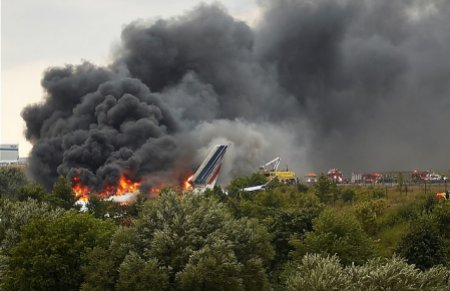As more details of accident emerge, Transport Canada evaluates ways of minimising the danger of overruns
The Air France Airbus A340-300 that overran at Toronto Pearson International airport on 2 August touched down so far along the runway that investigators believe it was all but impossible for it to be stopped on the concrete remaining, given the prevailing weather conditions. Meanwhile, Transport Canada says it is studying the potential of emerging technologies to minimise aircraft damage and injuries in the event of a runway overrun and is reviewing standards at the country’s airports.
The Transportation Safety Board of Canada (TSBC) says the primary reason for the Air France flight AF358 overrun, according to the flight data recorder (FDR), is that the aircraft touched down nearly half-way along Pearson’s 2,745m (9,000ft) – excluding overruns – runway 24L in rain.
Lead investigator Real Levasseur says he is “pretty convinced there was no way the aircraft was going to be able to stop” under the prevailing conditions. He gives the touchdown point as 1,220m from the threshold, which would have left 1,525m remaining to the end of the runway, with a 60m runway overrun strip and 200m of off-runway level ground before the lip of the ravine in which the aircraft finally came to a halt.
Levasseur says that when the aircraft crossed the runway threshold it was between 50ft and 100ft from the ground with an indicated airspeed (IAS) of 146kt (270km/h) and ground speed of 164kt with engines at idle. The differential indicates an 18kt tailwind component at that height. At touchdown the IAS was 148kt, according to the FDR.
A business-class passenger on board the A340 has told Flight International how she pulled her seat belt “very tight” during the latter stages of the approach when she noticed that the runway “seemed to be going past for a long time before we landed”.
The TSBC says that as soon as the main wheels were on the runway, maximum reverse thrust was successfully applied and the spoilers deployed. Recorded brake pressure was correct, so there is no reason to believe the brakes were not effective. Aquaplaning has not yet been ruled out, according to Levasseur, but this will need more analysis. Another factor is that the second half of runway 24L has an average 0.07% downslope, says Levasseur, who also confirms that the pilots made no attempt to go around after touchdown.
According to the passenger witness, very soon after touchdown the landing run became extremely bumpy and the A340-300 finally came to a halt with several firm jolts. She adds that the aircraft had been holding for between 20min and 30min before making the approach and the captain had kept the passengers informed.

The first officer was the pilot flying, Levasseur says, and both pilots were extremely helpful when interviewed by the TSBC, although he would not reveal what was said. Levasseur confirms that all 309 people on board disembarked the A340-300 in about 90s, despite the fact that every seat was occupied (see box). The vast majority escaped using only three of the aircraft’s eight emergency exits.
Meanwhile, criticism from pilots about Pearson’s runways – particularly 24L with a ravine 200m beyond the overrun strip (Flight International, 9-15 August) – and firefighters has prompted Transport Canada to say it will study arrester-strip technology and high-density foam fire extinguishant to see if they are warranted.
Co-pilot last to leave The Airbus A340’s 309 occupants, comprising 297 passengers and 12 duty crew, carried out a copybook evacuation, vacating the widebody in around 90s. The cabin crew began the evacuation immediately after the A340 came to rest. Air France says that the accident aircraft was equipped with a 291-passenger, two-class cabin, and explains that the additional six passengers comprised three infants and three off-duty crew in jump seats. As the diagram illustrates, several of the A340-300’s eight exits were not used, or only partially used, due to various factors, including the proximity of the fire, obstructions or slide deployment issues. According to the investigators, the crew rejected the use of exits L3 (third from the front on the left) and L4 as unusable because they could see fire outside, and exit R3 because the escape chute had not deployed properly and there were “sharp obstacles” outside. Exit L2, just forward of the wing, “popped open” because of “fuselage stress” caused by impacts in the overrun, according to investigators, but it opened only partially and its slide did not deploy. Some passengers used it to evacuate despite this. Air France says the co-pilot was the last person to leave the aircraft, having conducted a search of the cabin to ensure it was clear. |
DAVID LEARMOUNT/LONDON
Source: Flight International























